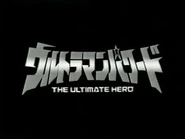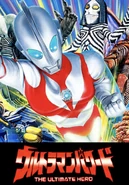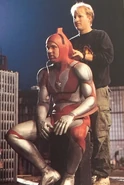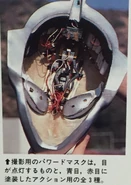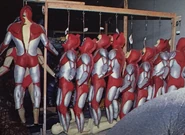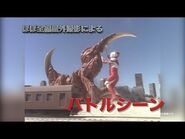Ultraman: The Ultimate Hero, known as Ultraman Powered in Japan, is a tokusatsu show co-produced by Major Havoc Entertainment (later renamed Steppin Stone Entertainment) and Tsuburaya Productions in the United States in 1993, running for 13 episodes. Following in the footsteps of the Australian-produced Ultraman: Towards the Future, this was the second live-action Ultraman Series produced outside Japan and the eleventh entry in the franchise overall.
Despite being produced in America, the show was never broadcast there. In Japan, the series released on home video from December 16, 1993, and later aired on Tokyo Broadcasting System from April 8 to July 1, 1995. After this series, Tsuburaya has since focused on domestic productions.
Production[]

Japanese poster by Noriyoshi Ohrai.
In the 1990s, the Australian-produced Ultraman: Towards the Future received positive reviews in Japan. The production committee model proved to be very effective in securing the production budget. Tsuburaya Productions initially planned to advance the second season of the series with the same character setup as Ultraman: Towards the Future, under the direction of Kiyoshi Suzuki.[1]
Given the immense response to Ultraman: Towards the Future produced in Australia, there was a plan to expand and shift the project to Hollywood. This situation led Kazuo Tsuburaya, who was in charge of Tsuburaya Productions' business at the time, to collaborate with Bandai in 1991 to develop a new Ultraman project. Compared to the reboot of Ultraman: Towards the Future, the new Ultraman series focused on reconstructing the world and characters from the 1966 series Ultraman, incorporating Hollywood techniques with the aim of creating popular monsters. This concept became the guide for determining the direction of the next overseas expansion.[1]
Ultraman: Towards the Future was broadcast in the United States in 1992 and achieved higher ratings. This trend significantly boosted Bandai America's product sales, leading to the introduction of the new Ultraman series in the U.S. This movement received approval from all relevant parties. In the summer of 1992, Japan's Gonzo production team collaborated with Bandai on the Ultraman: The Ultimate Hero project. The entire script and design for the series were completed in Japan by January 1993.[1]

Teaser of an American-produced Ultraman in a 1993 issue of Terebi Magazine.
The series' filming was a collaboration with Major Havoc Entertainment in the United States. The American side, led by director King Wilder, was responsible for translating the script into English. He and other American writers then rewrote the script locally, taking budget constraints into account.[2][3][4] Production and filming took place from the summer to the fall of 1993. The special effects scenes were primarily shot on open sets constructed in northern Los Angeles. The fight scenes were mainly filmed on these sets and other outdoor locations. Initially, the plan was to use the original designs of Ultraman and the monsters, but to ensure the uniqueness of the characters and for merchandise development, redesigns were made, incorporating more advanced special effects technology than what was available in Japan.[5]

The monster suits used in Ultraman: The Ultimate Hero are featured in this photo, which is part of the collection owned by Wes Caefer, who worked on the series' special effects.
Although the costume designs are vastly considered impressive, the action was quite downplayed compared to other installments of the Ultraman Series and consisted mostly of the actors nudging each other and using attacks involving special effects with minimal physical contact, due to the costumes being fragile and fear by the production staff of damaging them after the hard work put into crafting them.[6][7][8] Since Hollywood bore most of the production costs, the production control and rights were held by Hollywood. Tsuburaya Productions' rights were limited to merchandise sales within Japan.[5]
Synopsis[]
Kenichi Kai, a member of the special investigation agency WINR (pronounced "Winner"), is on a mission to investigate a mysterious object from outer space when he merges with Ultraman Powered, a Giant of Light who has come to Earth in pursuit of Alien Baltan. Learning of the various invaders and fiendish monsters that are targeting Earth, Kenichi vows to fight and protect Earth and preserve the peace. A battle of epic proportions begins all across America!
Characters[]
Protagonist[]
WINR[]
Others[]
- Officer Sam
- Officer Callahan
- Herlicki
- Roger Schecter
- Bamara
- Pete
- Katanga
- Kyle Morrison
- Keynes
- Windler
- Fenton
- Dr. Yusna
- Sean Malloy
- Mark Mitchell
- Dr. Whitaker
- Jesse
- Dennis
- Jamra Miller
- Karen Miller
- Patty Miller
- Colonel Essex
- Dan
- Potter
- Arturo Mendez
- Gurnaaz
- Dr. Hasegawa
- Sylvia Jackson
- General Garcia
Ultras[]
- Ultraman Powered: Simply called "Ultraman" in the original English version.
Kaiju[]
- Powered Alien Baltan
- Powered Kemular
- Powered Red King (male and female)
- Powered Chandlar
- Powered Pigmon
- Powered Telesdon
- Sun People
- Powered Gabora
- Powered Dada (A, B & C)
- Powered Aboras
- Powered Banila
- Powered Jamila
- Powered Zumbolar
- Powered Pestar
- Powered Gomora
- Powered Dorako
- Psycho Baltan
- Powered Zetton
Cast[]
| Character | English | Japanese Dub |
|---|---|---|
| Kenichi Kai | Kane Kosugi | Toshiyuki Morikawa |
| Russel Edlund | Harrison Page | Kenji Utsumi |
| Julie Young | Robyn Bliley | Aya Hisakawa |
| Theresa Beck | Sandra Guibord | Keiko Toda |
| Rick Sanders | Rob Roy Fitzgerald | Masashi Ebara |
| Voice of Ultraman Powered | Unknown | Sho Kosugi (episode 1) Akio Otsuka (episode 13) |
Guest Cast[]
| Character | English | Japanese Dub |
|---|---|---|
| Officer Callahan | Mari Weiss[9] | Mami Horikoshi |
| Officer Sam | Steven R. Barnett[9] | Shigeru Ushiyama |
| Herlicki | Conrad Bachmann[10] | Eken Mine |
| Rancher | Ed Morgan[10] | Yu Shimaka |
| Reporter | Patti Pelican[10] | Yuko Sasaki |
| Roger Schecter | Jeffrey Combs[11] | Takayuki Sugo |
| Bamara | Julie Uribe[11] | Yuko Sasaki |
| Pete | Philip Tanzini[11] | Masaki Aizawa |
| Katanga | Elias Gallegos[11] | Masayuki Omoro |
| Kyle Morrison | Alex Nevil[12] | Ken Narita |
| Seismologist | Judy Jean Berns[12] | Tamie Kubota |
| Army Officer | John Towey[12] | Toshihiko Kojima |
| Sun People's Leader | Bruce Spaulding Fuller[12] | |
| Sun People | Jim Eustermann[12] Kevin Hudson[12] |
Masaaki Tsukada Others |
| Mr. Keynes | Danny Hicks[13] | Toshihiko Kojima |
| Windler | Kevin Page[13] | Nobuaki Fukuda |
| Nuclear Power Plant Staff | Brenda Klemme[13] Ray Raglin[13] |
Atsuko Tanaka Ken Narita |
| Mining Company Employee | Art Bonilla[13] | Masaaki Tsukada |
| Fenton | Bill Mumy[13] | Naoki Bando |
| Dr. Yusna | Jack Ong[14] | Takehiro Koyama |
| Neuro Net Executive | Wendy Robie[14] | Kikuko Inoue |
| Mark Mitchell | Wolf Muser[14] | Hiroaki Hirata |
| Detective | Steve Eastin[14] | Takao Ohyama |
| Sean Malloy | Jeffery Thomas Johnson[14] | |
| Mark Mitchell's Neighbor | Rose Marie[14] | Ai Sato |
| Voice of Dada | Aruno Tahara | |
| Dr. Whitaker | Jason Todd Majik[15] | Takao Ohyama |
| Jesse | Catherine Nagan[15] | Kikuko Inoue |
| Dennis | John G. Hertzler[15] | Hiroaki Hirata |
| Waterworks Employee | Steve Monarque[15] | Takehiro Koyama |
| Whitaker's Assistant | Shano Palovich[15] | Ai Sato |
| Jamra Miller | Phillip Stewart[16] | Shinpachi Tsuji |
| Karen Miller | Marisa Theodore[16] | Akemi Okamura |
| Colonel Essex | John McCann[16] | Kinryuu Arimoto |
| Patty Miller | Kimberly Beck[16] | Keiko Aizawa |
| Potter | Jesse Goins[16] | Taro Arakawa |
| Dan | Steven Kramer[16] | Ryuji Mizuno |
| Firefighters | Michael Hungerford[17] Greg Callahan[17] Will Jeffries[17] Michael R. Long[17] |
Ryuji Mizuno |
| Arturo Mendez | Jaime P. Gomez[18] | Shigeki Kagemaru |
| Inspector | Tom Finnegan[18] | Yuzuru Fujimoto |
| Gurnaaz | Millie Novak[18] | Rica Fukami |
| Oil Company Employees | E.E. Bell[18] Martin Brinton[18] |
Yuichi Nagashima |
| Reporter | Judy Louise Johnson[18] | Kyoko Hikami |
| Dr. Hasegawa | Danny Kamekona[19] | Yuzuru Fujimoto |
| Sylvia Jackson | Sandra Spriggs[19] | Rica Fukami |
| Newscaster | Warren Stanhope[19] | Shinpachi Tsuji |
| Weather Forecaster | Dan Lorgé[19] | Yuichi Nagashima |
| Security Guard | Tracey Walter[19] | Masaaki Tsukada |
| Helicopter Pilots | Ted Prior[20] Karl A. Lucht[20] |
Nobuyuki Furuta Akio Otsuka |
| General Garcia | Harold Cannon-Lopez | Tamio Ohki |
Suit Actors[]
- Ultraman Powered: Scott Rogers
- Monsters:
- Monty L. Simons
- Michael R. Long
- Terrance James
- Gary Paul
- Anthony Kramme
- Jennie Kaplan
Staff[]
- Director: King Wilder
- Screenwriters: King Wilder, John Douglas, Stephen Karandy, Bud Robertson, Todd Gilbert, Tim Lennane, Walter A. Doty III
- Original script writers: Kazunori Ito, Hiroshi Yamaguchi, John Douglas, Bud Robertson
- Executive producer: Noboru Tsuburaya
- Supervising producers: Makoto Yamashina, Noboru Tsuburaya
- Producers: Kazuo Tsuburaya, Shigeru Watanabe
- Assistant producers: Masato Oida, Tomoaki Imanishi
- Coordinators: Hirohiko Sueyoshi, Kiyotaka Ukawa, Kenichi Yatomi
- Production producer: Julie Avola[21]
- Special effects supervisor: Joseph Viskocil
- Music: Toshihiko Sahashi
- Monster and mechanical designers: Shinji Higuchi, Mahiro Maeda, Toshio Miike
- Ultraman and monster costume modeling: Kevin Hudson
- Casting director: Aaron Griffith
- Costume designer: Elizabeth Jett
- Production designer: Aron Osborne
- Directors of photography: Don E. Fauntleroy, Carlos Gonzalez Barreto
- Editors: Nina M. Gilberti, Vanick Moradian, King Wilder, Stephen R. Eckelberry
- 2nd unit director and 2nd unit director of photography: R. Michael Stringer
- Stunt coordinator: Gary Paul
- Japanese version director: Tsuyoshi Takahashi
- Translation: Keiko Sato
- Coordination: Toru Kumakura
- Japanese version production: Tohokushinsha
- Production company: Major Havoc Entertainment (later renamed Steppin Stone Entertainment)
- Production: Tsuburaya Productions, Ultraman Powered Production Committee (Bandai Visual, Kodansha, Suntory, Marubeni, Yomiko Advertising)
Veteran makeup artist and Ultraman Series fan Steve Wang was briefly involved with the production of the show. He and his team created a miniature suit model of Ultraman which Tsuburaya Productions approved.
Music[]
- Opening Theme
- Ultraman Powered : The opening theme. The US version uses an instrumental version.
- Lyrics: Goro Matsui
- Composition: Suzuki Kisaburo
- Arrangement: Tatsumi Yano
- Artist: Tatsuya Maeda
- Ending Themes
- Kono Uchu no Doko ka ni
- Lyrics: Goro Matsui
- Composition: Suzuki Kisaburo
- Arrangement: Tatsumi Yano
- Artist: Tatsuya Maeda
- STARLIGHT FANTASY
- Lyrics: MoriYuki KoreSusumu C
- Composition: YoMinoru Akihiro
- Arrangement: Y2
- Artist: Hitomi Sudo
Gallery[]
Behind the Scenes[]
Videos[]
Trivia[]
- When broadcast in Japan in 1995, episodes 6 to 9 were aired in a different order: 8, 9, 6, 7.
- As seen in the Blu-ray release, Ultraman: The Ultimate Hero is the only Heisei Ultra Series to be shot in high definition.
- Like Ultraman: Towards the Future, Ultraman: The Ultimate Hero is one of the few Ultraman Series not to have an official DVD release.
- The show spawned a video game, called Ultraman Powered, released for the 3DO Interactive Multiplayer.
- Sho Kosugi, who provides Ultraman Powered's voice in the first episode of the Japanese dub, is the father of Kane Kosugi, who plays Kenichi Kai.
- This series marks the first time a Red King that is actually red appeared (as opposed to gold and blue).
- Alongside its broadcast in Japan, the series would air in a few other countries too: Thailand would air it on Channel 3 in 1995, and Spain would have it air on TVE-1 in 1994 (referred to as just Ultraman).
- Ultraman: The Ultimate Hero is one of the shows that has not yet been released as part of TSUBURAYA IMAGINATION's streaming list.
- Based on the feedback from the series' original Japanese scriptwriter, Kazunori Ito, he initially had a rather negative view of the series. On his personal page, he referred to it as a failed project. He explained that American screenwriters rewrote the script and filmed it according to their approach, but during this rewrite, much of the essence of his script was heavily cut and even misunderstood. Despite attending meetings in the United States with other Japanese staff members, the final film failed to capture what he had intended, leaving him disappointed. However, it was through this process that he met Shinji Higuchi, and their connection eventually led to Ito’s involvement in the creation of the Heisei Gamera Trilogy.[22]
- In a 2019 testimony, Ito reiterated his views on the series. He explained that, lacking confidence in his ability to write the script alone, he collaborated with another writer. Despite this, the strict contract culture in the U.S. meant that any delay past the delivery date would result in penalties, so he pushed himself to finish the script. When discussing his original ideas, Ito mentioned that it was essential to include the Alien Baltan. He also added other elements from series he personally liked.[23]
- However, he also noted a fundamental difference between the Japanese concept of "kaiju" and the Western idea of "monster." This cultural discrepancy caused confusion when he attended meetings in the U.S., where the concept of "kaiju" wasn’t understood. The American team simply saw the creatures as "monsters,". Ito felt that the meetings were a failure, and when he returned to Japan, he was somewhat disheartened.

The original building model created by the American team for Ultraman: The Ultimate Hero (left) and the revised model after supervision by the Japanese team (right).
- In a 2016 interview, Shinji Higuchi shared a experience when a producer he was working with suddenly declared, "Next, we're heading to America." However, upon arriving in the U.S., their initial creative vision failed to materialize effectively. Furthermore, the miniature models created by the American team were of such poor quality that they decided to assist in rebuilding them. Unfortunately, due to work authorization constraints, their involvement was limited to offering suggestions. Whether their recommendations were followed was beyond their control, a situation that left Higuchi deeply frustrated.[24]
- After returning to Japan, the Japanese production team held a meeting. When Kazunori Ito presented the Gamera: Guardian of the Universe project to Higuchi, he decided to dedicate himself to its production. This opportunity allowed them to address the regrets from Ultraman: The Ultimate Hero, which were later expressed in the Heisei Gamera series.

The city model after the revisions were made.
- In a 2022 interview, Higuchi reiterated that his involvement in the series was due to an invitation from producer Shigeru Watanabe of Bandai. He had been invited to participate in the special effects production of The Man Who Wanted to Be Ultraman, but he did not publicly inform Tsuburaya's staff that he was heading to the U.S. to shoot Ultraman.[25]
- Higuchi mentioned that upon arriving in the U.S., he found the filming set to be far from the glamorous Hollywood blockbuster environment he had imagined. The studio was filled with poorly made building models resembling lanterns, and at first, he thought these were props used for camera testing. Realizing the seriousness of the situation, he turned to Watanabe for assistance. Thanks to intervention from sponsors, Watanabe helped transform the lantern-like models into something resembling downtown Los Angeles buildings.
- Due to the expiration of his visa, Higuchi was unable to participate in the actual filming. However, he provided suggestions on how they should shoot the scenes and set up miniatures in a parking lot, taking a few commemorative photos.
External Links[]
References[]
- ↑ 1.0 1.1 1.2 Ultra Tokusatsu PERFECT MOOK vol. 18: Ultraman Great / Ultraman Powered, pg 20
- ↑ https://vantagepointinterviews.com/2018/08/07/the-ultimate-director-king-wilder-on-directing-americas-take-on-ultraman/
- ↑ https://vantagepointinterviews.com/2020/07/25/bringing-the-easts-greatest-hero-to-the-west-todd-gilbert-on-scripting-ultraman-the-ultimate-hero/
- ↑ https://vantagepointinterviews.com/2018/09/01/ultraman-gets-a-rewrite-john-douglas-on-scripting-ultraman-the-ultimate-hero/
- ↑ 5.0 5.1 Ultra Tokusatsu PERFECT MOOK vol. 18: Ultraman Great / Ultraman Powered, pg 21
- ↑ https://vantagepointinterviews.com/2022/08/01/ultraman-flies-into-hollywood-eric-brown-on-his-design-and-modelmaking-work-on-ultraman-the-ultimate-hero/
- ↑ https://vantagepointinterviews.com/2018/07/01/how-to-make-ultraman-kevin-hudson-on-his-experience-creating-ultraman-the-ultimate-hero/
- ↑ https://vantagepointinterviews.com/2018/07/01/living-the-dream-wes-caefers-journey-into-japanese-monster-sfx/
- ↑ 9.0 9.1 Episode 1 credits
- ↑ 10.0 10.1 10.2 Episode 2 credits
- ↑ 11.0 11.1 11.2 11.3 Episode 3 credits
- ↑ 12.0 12.1 12.2 12.3 12.4 12.5 Episode 4 credits
- ↑ 13.0 13.1 13.2 13.3 13.4 13.5 Episode 5 credits
- ↑ 14.0 14.1 14.2 14.3 14.4 14.5 Episode 6 credits
- ↑ 15.0 15.1 15.2 15.3 15.4 Episode 7 credits
- ↑ 16.0 16.1 16.2 16.3 16.4 16.5 Episode 8 credits
- ↑ 17.0 17.1 17.2 17.3 Episode 9 credits
- ↑ 18.0 18.1 18.2 18.3 18.4 18.5 Episode 10 credits
- ↑ 19.0 19.1 19.2 19.3 19.4 Episode 11 credits
- ↑ 20.0 20.1 Episode 12 credits
- ↑ https://vantagepointinterviews.com/2018/08/03/remembering-ultraman-the-ultimate-hero-producer-julie-avola-on-bringing-japans-greatest-hero-stateside/
- ↑ https://www.kyo-kan.net/k-ito/works/etc_001.html
- ↑ https://moviewalker.jp/news/article/210812/
- ↑ https://www.crank-in.net/feature/2016_ultraman_50th/
- ↑ https://moviewalker.jp/news/article/1065789/p2/


